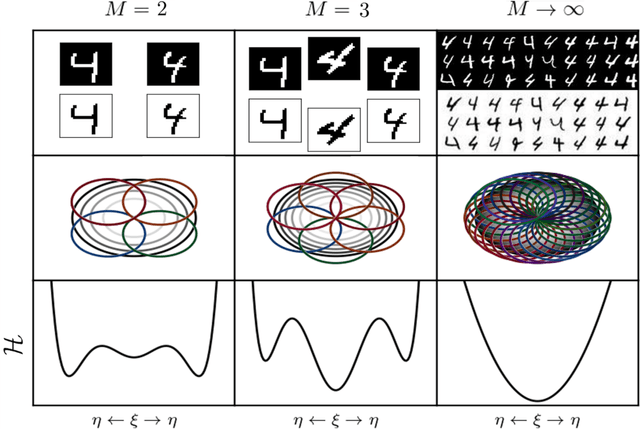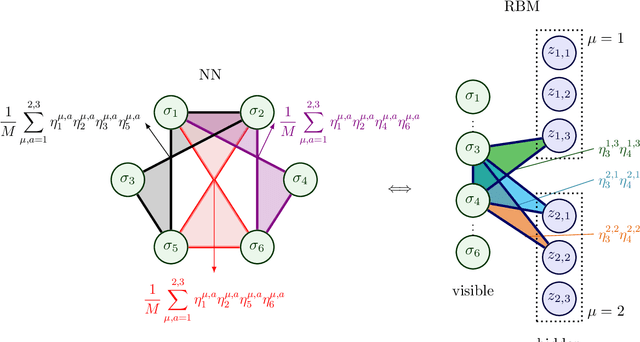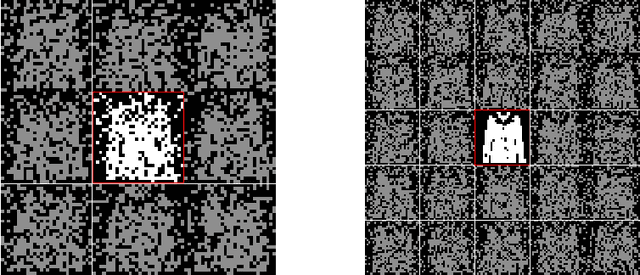Andrea Alessandrelli
Beyond Disorder: Unveiling Cooperativeness in Multidirectional Associative Memories
Mar 06, 2025Abstract:By leveraging tools from the statistical mechanics of complex systems, in these short notes we extend the architecture of a neural network for hetero-associative memory (called three-directional associative memories, TAM) to explore supervised and unsupervised learning protocols. In particular, by providing entropic-heterogeneous datasets to its various layers, we predict and quantify a new emergent phenomenon -- that we term {\em layer's cooperativeness} -- where the interplay of dataset entropies across network's layers enhances their retrieval capabilities Beyond those they would have without reciprocal influence. Naively we would expect layers trained with less informative datasets to develop smaller retrieval regions compared to those pertaining to layers that experienced more information: this does not happen and all the retrieval regions settle to the same amplitude, allowing for optimal retrieval performance globally. This cooperative dynamics marks a significant advancement in understanding emergent computational capabilities within disordered systems.
Unsupervised and Supervised learning by Dense Associative Memory under replica symmetry breaking
Dec 15, 2023



Abstract:Statistical mechanics of spin glasses is one of the main strands toward a comprehension of information processing by neural networks and learning machines. Tackling this approach, at the fairly standard replica symmetric level of description, recently Hebbian attractor networks with multi-node interactions (often called Dense Associative Memories) have been shown to outperform their classical pairwise counterparts in a number of tasks, from their robustness against adversarial attacks and their capability to work with prohibitively weak signals to their supra-linear storage capacities. Focusing on mathematical techniques more than computational aspects, in this paper we relax the replica symmetric assumption and we derive the one-step broken-replica-symmetry picture of supervised and unsupervised learning protocols for these Dense Associative Memories: a phase diagram in the space of the control parameters is achieved, independently, both via the Parisi's hierarchy within then replica trick as well as via the Guerra's telescope within the broken-replica interpolation. Further, an explicit analytical investigation is provided to deepen both the big-data and ground state limits of these networks as well as a proof that replica symmetry breaking does not alter the thresholds for learning and slightly increases the maximal storage capacity. Finally the De Almeida and Thouless line, depicting the onset of instability of a replica symmetric description, is also analytically derived highlighting how, crossed this boundary, the broken replica description should be preferred.
Parallel Learning by Multitasking Neural Networks
Aug 08, 2023Abstract:A modern challenge of Artificial Intelligence is learning multiple patterns at once (i.e.parallel learning). While this can not be accomplished by standard Hebbian associative neural networks, in this paper we show how the Multitasking Hebbian Network (a variation on theme of the Hopfield model working on sparse data-sets) is naturally able to perform this complex task. We focus on systems processing in parallel a finite (up to logarithmic growth in the size of the network) amount of patterns, mirroring the low-storage level of standard associative neural networks at work with pattern recognition. For mild dilution in the patterns, the network handles them hierarchically, distributing the amplitudes of their signals as power-laws w.r.t. their information content (hierarchical regime), while, for strong dilution, all the signals pertaining to all the patterns are raised with the same strength (parallel regime). Further, confined to the low-storage setting (i.e., far from the spin glass limit), the presence of a teacher neither alters the multitasking performances nor changes the thresholds for learning: the latter are the same whatever the training protocol is supervised or unsupervised. Results obtained through statistical mechanics, signal-to-noise technique and Monte Carlo simulations are overall in perfect agreement and carry interesting insights on multiple learning at once: for instance, whenever the cost-function of the model is minimized in parallel on several patterns (in its description via Statistical Mechanics), the same happens to the standard sum-squared error Loss function (typically used in Machine Learning).
Dense Hebbian neural networks: a replica symmetric picture of supervised learning
Nov 25, 2022



Abstract:We consider dense, associative neural-networks trained by a teacher (i.e., with supervision) and we investigate their computational capabilities analytically, via statistical-mechanics of spin glasses, and numerically, via Monte Carlo simulations. In particular, we obtain a phase diagram summarizing their performance as a function of the control parameters such as quality and quantity of the training dataset, network storage and noise, that is valid in the limit of large network size and structureless datasets: these networks may work in a ultra-storage regime (where they can handle a huge amount of patterns, if compared with shallow neural networks) or in a ultra-detection regime (where they can perform pattern recognition at prohibitive signal-to-noise ratios, if compared with shallow neural networks). Guided by the random theory as a reference framework, we also test numerically learning, storing and retrieval capabilities shown by these networks on structured datasets as MNist and Fashion MNist. As technical remarks, from the analytic side, we implement large deviations and stability analysis within Guerra's interpolation to tackle the not-Gaussian distributions involved in the post-synaptic potentials while, from the computational counterpart, we insert Plefka approximation in the Monte Carlo scheme, to speed up the evaluation of the synaptic tensors, overall obtaining a novel and broad approach to investigate supervised learning in neural networks, beyond the shallow limit, in general.
Dense Hebbian neural networks: a replica symmetric picture of unsupervised learning
Nov 25, 2022



Abstract:We consider dense, associative neural-networks trained with no supervision and we investigate their computational capabilities analytically, via a statistical-mechanics approach, and numerically, via Monte Carlo simulations. In particular, we obtain a phase diagram summarizing their performance as a function of the control parameters such as the quality and quantity of the training dataset and the network storage, valid in the limit of large network size and structureless datasets. Moreover, we establish a bridge between macroscopic observables standardly used in statistical mechanics and loss functions typically used in the machine learning. As technical remarks, from the analytic side, we implement large deviations and stability analysis within Guerra's interpolation to tackle the not-Gaussian distributions involved in the post-synaptic potentials while, from the computational counterpart, we insert Plefka approximation in the Monte Carlo scheme, to speed up the evaluation of the synaptic tensors, overall obtaining a novel and broad approach to investigate neural networks in general.
 Add to Chrome
Add to Chrome Add to Firefox
Add to Firefox Add to Edge
Add to Edge